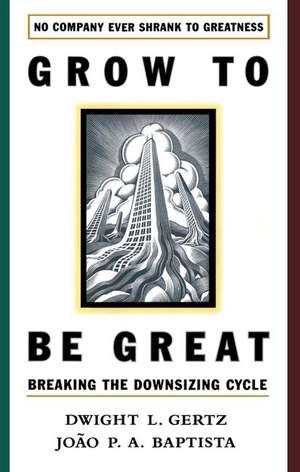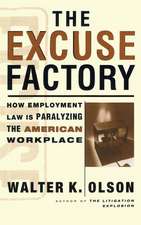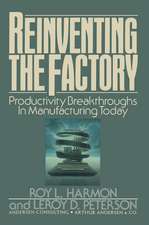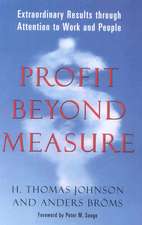Grow to be Great: Breaking the Downsizing Cycle
Autor Joao P.A. Baptista, Dwight L. Gertzen Limba Engleză Paperback – 6 sep 2007
Using case studies, Gertz and Baptista analyze successful high-growth firms such as Starbucks, Staples, USAA. They examine not only the strategies followed by these companies -- customer franchise management, superior new product development, and channel management -- but also what they did to make these strategies successful. They discuss how, regardless of differences in strategic approach, the transformations achieved by these firms are based on the same three "foundations for growth": superior customer value, outstanding economics across the value chain, and excellence in process execution. They demonstrate how these three foundations work together, forming a powerful framework through which to attain corporate goals.
Distilling these findings into useful tools for the evaluation of any strategy, Gertz and Baptista show how those facing the difficult task of turnaround can get back to growth. By examining improvements at four companies within the context of their growth framework, they analyze the combination of inspiration, leadership, and technique which has enabled these firms to prosper.
Shifting the focus from cost-cutting to growth is a challenge that thousands of companies must now face. Gertz and Baptista have given CEO's, managers, and consultants in every industry a clear framework from which to build sustainable growth in revenues and profits. This book is a practical and colorful guide for those who want to grow to be great.
Preț: 98.53 lei
Nou
Puncte Express: 148
Preț estimativ în valută:
18.86€ • 20.49$ • 15.85£
18.86€ • 20.49$ • 15.85£
Carte disponibilă
Livrare economică 31 martie-14 aprilie
Preluare comenzi: 021 569.72.76
Specificații
ISBN-13: 9781416576358
ISBN-10: 1416576355
Pagini: 224
Dimensiuni: 152 x 229 x 13 mm
Greutate: 0.28 kg
Editura: Free Press
Colecția Free Press
ISBN-10: 1416576355
Pagini: 224
Dimensiuni: 152 x 229 x 13 mm
Greutate: 0.28 kg
Editura: Free Press
Colecția Free Press
Notă biografică
Dwight L. Gertz is a vice president in the General Management Consulting Practice at Mercer Management Consulting. He lives in Lincoln, Massachusetts.
Extras
Chapter 1: YOU CANNOT SHRINK TO GREATNESS
America's great corporations have been on a size reduction regimen for over a decade. Downsizing, "rightsizing," restructuring, and reengineering are very different terms that collectively describe this great corporate shrinking act. To their advocates, these are surgical tools for reshaping bloated and inefficient organizations. In the right hands and in the right situations these tools have been effective in improving business performance. Misused, however, these represent little more than analytical excuses for wholesale unemployment.
The downsizing of American corporations, one of the economic landmarks of the 1980s and 1990s, has had profound implications for the middle class, and has left no group of employees untouched. It has spread beyond the traditional class of victims -- blue-collar and lower-level clerical workers -- to the ranks of managers and technical professionals. According to a 1987 study by the Conference Board, U.S. corporations eliminated more than a million managers and professional staff positions between 1979 and 1987. And the impulse to shrink corporate headcounts among these employee categories continues unabated.
Some of the biggest companies have been the biggest shedders of personnel. Between 1982 and 1992, General Electric reduced its work force by 25 percent, or 100,000 employees. In 1993-1994, NCR cut 21,500 positions. Atlantic Richfield began the 1980s with a work force of 50,000; less than half of that number remains with the firm today. Sears, Kodak, and Procter & Gamble were also among the shrinking giants of the early 1990s, accounting for well over 73,000 lost positions -- many in the managerial ranks. Taken together, the Fortune 500 industrial companies managed to shed 2.6 million jobs between 1984 and the end of 1993. Even among Fortune 500 service companies, current employment has shrunk to 1989 levels.
In general, the huge work force cuts in American corporations have not been tied to performance in the overall economy. In fact, some of the biggest force reductions have coincided with a period of national economic growth. Everyone expects big personnel cuts during hard times, and the recession of 1990-1992 proved to be no exception. Some 1.6 million jobs were lost during that period. But according to a recent American Management Association (AMA) study, as little as one-third of these employment reductions can be attributed solely to general business conditions. Some other factor has been at work, eliminating positions on a permanent basis. The pattern of restaffing that normally follows a recession did not occur once the economic engines of the country regained their momentum. America's big corporations didn't hire many people back, in part because a large percentage of the original layoffs -- an estimated 680,000 -- were attributable to corporate downsizing. Fewer positions needed to be refilled once the recession ended. Many corporations, in fact, just kept on cutting as the economic recovery surged forward in 1993-1994.
A BRIEF HISTORY OF CORPORATE SHRINKAGE
Downsizing was a response to a situation that faced many major U.S. corporations. In general, the first companies to begin the process of downsizing were those hit by direct foreign competition in the late 1970s: companies in steel, machine tools, automobiles, and electronics. These firms recognized that they had massive cost disadvantages, primarily in comparison with their Japanese competitors. Automakers, for example, discovered that they had roughly a $1,000 per vehicle cost disadvantage when compared to Japanese vehicles in the small-car category. Only a small part of this startling difference was traceable to direct labor, the traditional whipping boy for U.S. cost problems. The bulk of the difference was embedded in other cost structures of the corporation, in particular, the number of middle managers and engineers throughout the company. Sheer survival for Chrysler and other industrial companies required massive reductions in the number of "suits" on the payroll.
American steel was another industry to feel the heat during the late 1970s and early 1980s. Companies saw their profit margins evaporating and jumped to the conclusion that foreign competitors, chiefly in Japan, were dumping steel onto the U.S. market at less than their own costs of production. Studies of Japanese steel-making costs, however, pointed to a different conclusion. The Japanese were actually making a profit on their U.S. sales. They enjoyed such favorable cost structures that they could sell beneath the prices of U.S. competitors and still enjoy healthy margins. Big Steel found itself squeezed as well by domestic rivals like Nucor, which had made tremendous innovations in the production of steel.
The wave of Japanese competition that began in the 1970s did not confine itself to heavy manufacturing but spread to other sectors where U.S. firms supposedly enjoyed important advantages in technology and innovation. Xerox Corporation, which had dominated the market for photocopying machines, found itself in a similar cost predicament. In 1981, Xerox discovered that machines offered by Minolta, Ricoh, Canon, Toshiba, and other Japanese firms were selling at prices that were less than Xerox's own cost of production! And the new Japanese machines offered equal or greater quality and reliability. Three years later, William F. Glavin, then Xerox executive vice president, summarized his company's problems in a statement that described the cost problems of many American companies at the time: "Our manufacturing facilities were highly labor intensive. We built up a huge overhead structure of indirect white-collar workers. Our organization was bogged down with far too many checks and balances."
Clearly, the behemoths of U.S. industry would have to get lean and mean if they hoped to compete and maintain leadership in the future. Xerox's response was thoughtful and effective. Through its partner, Fuji-Xerox, it learned and adopted Japanese principles of quality management and product design that had given Japanese companies such a cost and quality advantage. Other U.S. firms in electronics, autos, and other industries followed a similar course, bringing costs and quality into line with the wave of tough new competition sweeping their markets.
At the same time, these companies sought ways to eliminate layers of bureaucracy and management. Some did it for all the right reasons: too many layers added to costs, slowed the pace of decision making, and isolated decision makers from both customers and their own line workers. Others companies simply took a broad-ax approach to eliminating employees.
Freight rail is another example of a stagnant and bloated industry in which downsizing, restructuring, and reengineering were long overdue. Until 1980, rail companies were kept at inefficient levels of staffing by a century of government regulation and labor agreements that thwarted technological advancement, even as truckers were stripping rail transport of the most attractive segments of the freight business.
Deregulation during the 1980s changed this situation abruptly, with the result that massive layoffs swept away more than half of all employment in the industry. Thanks to these various downsizing and reengineering efforts, the freight rail industry is experiencing a renaissance, gaining market share once lost to the trucking industry.
For other companies, the imperative to downsize has been driven by a simple fact: their product markets are shrinking and there are no new products to create growth. Consider the plight of thousands of U.S. defense contractors. With the Cold War now behind us, the market for most defense-related products is declining on a year-to-year basis. If you're in the business of building nuclear submarines, you must either develop new product markets and/or downsize the company as your backlog of orders dries up.
In general, the drive to reduce costs and gain operating efficiencies has taken these directions:
* Consolidation of operations. This is the usual outcome in the case of major acquisitions. Entire departments and production facilities become redundant. Eliminating people, particularly non-unionized, white-collar workers, is usually the quickest and easiest cost-saving step.
* Sale or elimination of noncritical units.
* Using fewer assets. Just-in-time methods make it possible to reduce inventories and the people who handle them. In a related sense, financial managers have found ways to reduce the amount of working capital needed to operate the companies. Redesign of products and processes leads to lower raw material requirements and fewer assembly steps.
* Reengineer key processes. Because the goal of reengineering is to improve the ratio of work output to work input, most companies that adopt this improvement methodology eliminate workers. In a 1994 study by CSC Index, 73 percent of U.S. and 84 percent of European companies responded that reengineering would eliminate jobs, typically by about 21 percent. The same study notes that although reengineering can be used for both cost reduction and revenue growth, "to date, it appears, it has been used more to cut costs (and often people)."
LIMITATIONS OF DOWNSIZING
On the surface, a strategy of downsizing to achieve operational efficiencies seems eminently logical. After all, a company that is more efficient than its competitors can either reap higher profit margins or underprice them to win greater market share. Unfortunately, none of the business improvement skills that make it possible to become the lowest-cost, most responsive, highest-quality producer are proprietary. These skills can be learned and applied by just about any company anywhere in the world. Japanese firms discovered this to their regret as one American company after another adopted just-in-time and total quality programs. U.S. automakers sought the advice of the same quality experts who had taught the principles of quality management to their Japanese competitors.
Over time, American firms closed the quality and cost gaps that had made their products less desirable than foreign models. But these pioneers of business improvement soon found that their domestic competitors could do the same. This was a game that anyone could play. The result is that cost and quality have become moving targets. Quality has continued to rise and costs have continued to fall, creating a kind of treadmill for many companies.
A strategy of downsizing is also limited by the fact that it may not address the fundamental problem in a particular business. Costs, after all, are not the only business problem. For some companies, the problem is not how they do things but what they do. If you had been the CEO of a phonograph record manufacturer not so many years ago, you would have discovered that no amount of cost reduction or effectiveness gained through reengineering would have kept your company afloat. Demand for vinyl records -- at any price -- simply disappeared. Companies in this situation need "reinvention" more than they need restructuring or reengineering. They need to offer entirely new products or services that build on their historic strengths.
Given these limitations, there is every reason to theorize that downsizing may be a strategy whose time has passed.
THE DIMINISHING VALUE OF DOWNSIZING
Fortunately, we do not have to rely on theory to infer the long-term results of downsizing and other cost-cutting strategies. So many companies have adopted these strategies that we can observe the outcomes directly. Since 1988, the American Management Association has been surveying the work force reductions of its members. Concentrated on larger firms (over $10 million in revenues) and on manufacturing companies, the AMA's studies give us a picture of what is going on and why.
According to an AMA survey released in 1993, fewer than half (45 percent) of downsizing companies reported an increase in operating profits. Almost the same percentage of firms experienced either no change or an actual decline in operating profits after downsizing.
Since most of these initiatives were motivated by the need to boost operating profits, these results can only be viewed as discouraging. Worse still, two-thirds of the downsizing companies have gone back for two or more rounds of work force reductions. Clearly, the cost reduction impulse can be addictive and executives need continuing "quick fixes" to bolster their bottom lines.
Every downsizing initiative, of course, leaves a smaller organization from which to extract the next round of cost savings. Over subsequent rounds, cost cutting must have diminishing returns. In this sense, downsizing is only a short-term fix with limited value to an organization. Corporate anorexia is not a sensible way to get healthy.
Evidence is also growing that downsizing is an uncertain strategy. In fact, a study by CSC Index indicates that fewer than one-third of process reengineering initiatives met or exceeded their goals. Admittedly, similar poor results could be cited for business improvement schemes of the past, including matrix management and total quality management. This is not to condemn the principles behind these improvement plans, which are often sound. In most cases, failure results because the principles were either poorly applied or applied to inappropriate business situations.
THE SHAREHOLDERS' VIEW
Driven to downsize in order to maintain shareholder value, what have managers accomplished? Using the Fortune 1000 companies in the period 1988 through 1993 as a sample, we have sorted the American business world into four groups to which we have provided shorthand names: Shrinkers, Cost Cutters, Unprofitable Growers, and Profitable Growers.
The Shrinkers. Shrinkers, by our definition, are companies whose revenues and operating profits have grown more slowly than the industry in which they compete. In relative terms they are shrinking in both revenues and profits against their competitors.
The Cost Cutters. These companies have grown revenues more slowly than their industry, but have grown profits more rapidly. The implication is that the profit growth came largely through cost reductions. We would expect to find many of our downsizing and reengineered companies in this group. Cost Cutters create profits for shareholders, but even the most effective Cost Cutters must eventually reach a point where costs are zero percent of sales, at which point they must grow revenues in order to continue the growth of profits.
The Unprofitable Growers. Companies in this group, by contrast, have managed to increase revenues faster than the industries in which they compete, but without commensurate growth in operating profits.
The Profitable Growers. These companies have managed to increase both revenue and profits more rapidly than their industry competitors during the period 1988-1993. It is this group of companies from which we draw most of the examples throughout this book, and it is in this group that every company would like to find itself.
The distribution of Fortune 1000 companies within this typology of firms is represented in Figure 1-2. Note how wide the distribution is. There are some dramatic winners and losers from which we should be able to learn.
The stock market values these company types very differently. In a recent study of nearly 1,000 large U.S. companies, we found clear evidence that, as far as the stock market is concerned, a penny saved is not as valuable as a penny earned. Investors place a much higher value on companies that improved their bottom lines through revenue growth than through cost cutting. From 1988 through 1993, the compound annual growth rate in the market value of these "Profitable Growers" was 19 percent. Over that same period, the companies that achieved higher-than-average operating profit growth but lower-than-average revenue growth -- the "Cost Cutters" -- saw their market value grow only 12 percent annually. Profitable growth, in other words, was rewarded much more richly than effective cost-cutting. The "Unprofitable Growers" are further behind in the pack at 8 percent, and "Shrinkers" are at the bottom with 5 percent.
The reason for this clear preference for profitable revenue growth may be a recognition on the part of investors that gains made through cost cutting represent either a single event or one that can only be repeated a limited number of times. Eventually, cost cutters run out of fat to trim and competitors can often match their cost reductions, leaving the original cost cutters in the same market position. But enterprises that generate new profits from growing revenues are building a profit machine capable of generating a future stream of profits. In the final analysis, it is that future stream of profits that investors are paying for.
This willingness to pay for future profits also manifests itself in the price that the securities markets charge for capital. As Figure 1-4 shows, Profitable Growers are much more likely to earn the cost of capital. Many financial theorists believe that long-term corporate survival depends on the ability to earn returns higher than the cost of capital that the market charges for debt and equity capital.
MORALE AND PRODUCTIVITY
In addition to the quantifiable benefit of being a Profitable Grower instead of a Cost Cutter, there are other benefits that we believe are equally important but harder to measure: morale and productivity.
It is easy to believe that an organization whose employees are systematically reduced in number will have low morale. The people left behind generally remain at their posts with a sense of impending doom, knowing that they could be the next to go and that no one's job is truly safe. One company's experience makes the point clear. In describing the ongoing head count reductions at Scott Paper in the summer of 1994, New York Times reporter Glen Collins wrote: "Many Scott employees are in a state of shock, dread and anger as they wait for their managers to decide who will go and who will stay." Many of those who remain end up picking up part of the work left behind by furloughed colleagues -- often with no added pay.
A 1994 study of more than 4,000 American workers conducted by Wyatt Co. found that only 57 percent of workers in downsizing companies were generally satisfied with their work, as opposed to 72 percent in growing companies. How this sense of siege among employees translates into costs for the company is easy to understand, and evidence makes clear what we all know intuitively: that in an age when knowledge, know-how, and human ingenuity are more important than capital and physical labor, it doesn't pay to demoralize workers.
The rumors, gossip, and lifeboat mentality that prevail in most downsizing and restructuring situations are not conducive to morale or productivity. Not surprisingly, the AMA study indicates that 80 percent of downsizing companies experienced downturns in morale. "The surest after-effect," it found, "is declining work force morale, which affects productivity and, in turn, profits." The survey indicates that only one-third of the downsized companies experienced increased employee productivity.
To their credit, a great number of firms attempt to soften the blow of work force reduction. Often those with the greatest length of service to the company are protected, and gradual reductions through attrition are common. Ironically, these well-meaning policies may be damaging in the long run, resulting in an aging work force and hiring freezes that bar the door to young, energetic, and newly trained personnel. This is particularly worrisome to technology firms that rely on fresh blood to keep themselves on the leading edge of their markets.
There is also mounting evidence that managers who remain with downsizing companies may be very negatively affected by the experience. They are the ones who must deliver the pink slips, and they are the ones who often pick up the work of their departed comrades. Psychologists who have studied these managers often describe them as stressed, morose, more cautious, and fatigued. Some speak of "survivor's sickness" the combination of guilt and depression that often afflicts survivors of plane crashes and military combat. Yet these managers are the very core employees upon whom downsized companies depend for leadership and creative solutions.
MANAGERIAL TUNNEL VISION
Despite all that has happened, many companies believe that they are poised for growth -- even those whose performance over the past several years has been disappointing. Important segments of U.S. business have taken their medicine; they have improved quality and cycle times, and have narrowed or eliminated cost differentials with foreign competitors. Today, the cost of producing a ton of steel or a personal computer or any number of other products and services has been dramatically reduced. Unit labor costs in American industry fell by an average of 6.4 percent a year during the period 1985-1993.Where downsizing has not yet taken hold, as in Germany and Japan, these same cost measures have increased -- by 4.2 percent per year in Germany and 6.6 percent in Japan, as reported in The Economist.
But even for companies that have gained these efficiencies and swept away unproductive layers of bureaucracy and management, growth will not be automatic. There remains a barrenness of out-look as to what should come next. While business improvements of the 1970s and 1980s may have ensured their survival, they have done little to ensure prosperity. At the same time, 15 years of attention to continuous improvement, quality control, and reductions in staffing and cost have fostered managerial tunnel vision. This condition rivets executive thinking and energy on ways of gaining efficiencies in existing businesses while obscuring their vision of new possibilities for future growth.
Almost an entire generation of managers has adapted itself to the challenge of making companies smaller and more efficient at what they do. This has made them less able to envision what they must become. In a sense, these managers have become skilled in methodologies that ensure near-term survival, but few have gained experience in the skills that lead to a prosperous future.
It is difficult, though, to fault managers in this. Survival always comes first, and survival has been a central managerial challenge in American business for the past 15 years. Still, the challenge of today and tomorrow is growth, and growth requires a different mind-set and a different set of skills. Many CEOs with whom we have worked are keenly aware of this problem and wonder openly if their managers would know what to do with a growth opportunity if one should come their way.
We believe that these managers can break out of the cycle of downsizing and move their companies toward growth. This book contains examples of managers who have, and it explains the strategies and organizational capabilities that have made growth profitable.
Copyright © 1995 by Dwight L. Gertz and João P.A. Baptista
America's great corporations have been on a size reduction regimen for over a decade. Downsizing, "rightsizing," restructuring, and reengineering are very different terms that collectively describe this great corporate shrinking act. To their advocates, these are surgical tools for reshaping bloated and inefficient organizations. In the right hands and in the right situations these tools have been effective in improving business performance. Misused, however, these represent little more than analytical excuses for wholesale unemployment.
The downsizing of American corporations, one of the economic landmarks of the 1980s and 1990s, has had profound implications for the middle class, and has left no group of employees untouched. It has spread beyond the traditional class of victims -- blue-collar and lower-level clerical workers -- to the ranks of managers and technical professionals. According to a 1987 study by the Conference Board, U.S. corporations eliminated more than a million managers and professional staff positions between 1979 and 1987. And the impulse to shrink corporate headcounts among these employee categories continues unabated.
Some of the biggest companies have been the biggest shedders of personnel. Between 1982 and 1992, General Electric reduced its work force by 25 percent, or 100,000 employees. In 1993-1994, NCR cut 21,500 positions. Atlantic Richfield began the 1980s with a work force of 50,000; less than half of that number remains with the firm today. Sears, Kodak, and Procter & Gamble were also among the shrinking giants of the early 1990s, accounting for well over 73,000 lost positions -- many in the managerial ranks. Taken together, the Fortune 500 industrial companies managed to shed 2.6 million jobs between 1984 and the end of 1993. Even among Fortune 500 service companies, current employment has shrunk to 1989 levels.
In general, the huge work force cuts in American corporations have not been tied to performance in the overall economy. In fact, some of the biggest force reductions have coincided with a period of national economic growth. Everyone expects big personnel cuts during hard times, and the recession of 1990-1992 proved to be no exception. Some 1.6 million jobs were lost during that period. But according to a recent American Management Association (AMA) study, as little as one-third of these employment reductions can be attributed solely to general business conditions. Some other factor has been at work, eliminating positions on a permanent basis. The pattern of restaffing that normally follows a recession did not occur once the economic engines of the country regained their momentum. America's big corporations didn't hire many people back, in part because a large percentage of the original layoffs -- an estimated 680,000 -- were attributable to corporate downsizing. Fewer positions needed to be refilled once the recession ended. Many corporations, in fact, just kept on cutting as the economic recovery surged forward in 1993-1994.
A BRIEF HISTORY OF CORPORATE SHRINKAGE
Downsizing was a response to a situation that faced many major U.S. corporations. In general, the first companies to begin the process of downsizing were those hit by direct foreign competition in the late 1970s: companies in steel, machine tools, automobiles, and electronics. These firms recognized that they had massive cost disadvantages, primarily in comparison with their Japanese competitors. Automakers, for example, discovered that they had roughly a $1,000 per vehicle cost disadvantage when compared to Japanese vehicles in the small-car category. Only a small part of this startling difference was traceable to direct labor, the traditional whipping boy for U.S. cost problems. The bulk of the difference was embedded in other cost structures of the corporation, in particular, the number of middle managers and engineers throughout the company. Sheer survival for Chrysler and other industrial companies required massive reductions in the number of "suits" on the payroll.
American steel was another industry to feel the heat during the late 1970s and early 1980s. Companies saw their profit margins evaporating and jumped to the conclusion that foreign competitors, chiefly in Japan, were dumping steel onto the U.S. market at less than their own costs of production. Studies of Japanese steel-making costs, however, pointed to a different conclusion. The Japanese were actually making a profit on their U.S. sales. They enjoyed such favorable cost structures that they could sell beneath the prices of U.S. competitors and still enjoy healthy margins. Big Steel found itself squeezed as well by domestic rivals like Nucor, which had made tremendous innovations in the production of steel.
The wave of Japanese competition that began in the 1970s did not confine itself to heavy manufacturing but spread to other sectors where U.S. firms supposedly enjoyed important advantages in technology and innovation. Xerox Corporation, which had dominated the market for photocopying machines, found itself in a similar cost predicament. In 1981, Xerox discovered that machines offered by Minolta, Ricoh, Canon, Toshiba, and other Japanese firms were selling at prices that were less than Xerox's own cost of production! And the new Japanese machines offered equal or greater quality and reliability. Three years later, William F. Glavin, then Xerox executive vice president, summarized his company's problems in a statement that described the cost problems of many American companies at the time: "Our manufacturing facilities were highly labor intensive. We built up a huge overhead structure of indirect white-collar workers. Our organization was bogged down with far too many checks and balances."
Clearly, the behemoths of U.S. industry would have to get lean and mean if they hoped to compete and maintain leadership in the future. Xerox's response was thoughtful and effective. Through its partner, Fuji-Xerox, it learned and adopted Japanese principles of quality management and product design that had given Japanese companies such a cost and quality advantage. Other U.S. firms in electronics, autos, and other industries followed a similar course, bringing costs and quality into line with the wave of tough new competition sweeping their markets.
At the same time, these companies sought ways to eliminate layers of bureaucracy and management. Some did it for all the right reasons: too many layers added to costs, slowed the pace of decision making, and isolated decision makers from both customers and their own line workers. Others companies simply took a broad-ax approach to eliminating employees.
Freight rail is another example of a stagnant and bloated industry in which downsizing, restructuring, and reengineering were long overdue. Until 1980, rail companies were kept at inefficient levels of staffing by a century of government regulation and labor agreements that thwarted technological advancement, even as truckers were stripping rail transport of the most attractive segments of the freight business.
Deregulation during the 1980s changed this situation abruptly, with the result that massive layoffs swept away more than half of all employment in the industry. Thanks to these various downsizing and reengineering efforts, the freight rail industry is experiencing a renaissance, gaining market share once lost to the trucking industry.
For other companies, the imperative to downsize has been driven by a simple fact: their product markets are shrinking and there are no new products to create growth. Consider the plight of thousands of U.S. defense contractors. With the Cold War now behind us, the market for most defense-related products is declining on a year-to-year basis. If you're in the business of building nuclear submarines, you must either develop new product markets and/or downsize the company as your backlog of orders dries up.
In general, the drive to reduce costs and gain operating efficiencies has taken these directions:
* Consolidation of operations. This is the usual outcome in the case of major acquisitions. Entire departments and production facilities become redundant. Eliminating people, particularly non-unionized, white-collar workers, is usually the quickest and easiest cost-saving step.
* Sale or elimination of noncritical units.
* Using fewer assets. Just-in-time methods make it possible to reduce inventories and the people who handle them. In a related sense, financial managers have found ways to reduce the amount of working capital needed to operate the companies. Redesign of products and processes leads to lower raw material requirements and fewer assembly steps.
* Reengineer key processes. Because the goal of reengineering is to improve the ratio of work output to work input, most companies that adopt this improvement methodology eliminate workers. In a 1994 study by CSC Index, 73 percent of U.S. and 84 percent of European companies responded that reengineering would eliminate jobs, typically by about 21 percent. The same study notes that although reengineering can be used for both cost reduction and revenue growth, "to date, it appears, it has been used more to cut costs (and often people)."
LIMITATIONS OF DOWNSIZING
On the surface, a strategy of downsizing to achieve operational efficiencies seems eminently logical. After all, a company that is more efficient than its competitors can either reap higher profit margins or underprice them to win greater market share. Unfortunately, none of the business improvement skills that make it possible to become the lowest-cost, most responsive, highest-quality producer are proprietary. These skills can be learned and applied by just about any company anywhere in the world. Japanese firms discovered this to their regret as one American company after another adopted just-in-time and total quality programs. U.S. automakers sought the advice of the same quality experts who had taught the principles of quality management to their Japanese competitors.
Over time, American firms closed the quality and cost gaps that had made their products less desirable than foreign models. But these pioneers of business improvement soon found that their domestic competitors could do the same. This was a game that anyone could play. The result is that cost and quality have become moving targets. Quality has continued to rise and costs have continued to fall, creating a kind of treadmill for many companies.
A strategy of downsizing is also limited by the fact that it may not address the fundamental problem in a particular business. Costs, after all, are not the only business problem. For some companies, the problem is not how they do things but what they do. If you had been the CEO of a phonograph record manufacturer not so many years ago, you would have discovered that no amount of cost reduction or effectiveness gained through reengineering would have kept your company afloat. Demand for vinyl records -- at any price -- simply disappeared. Companies in this situation need "reinvention" more than they need restructuring or reengineering. They need to offer entirely new products or services that build on their historic strengths.
Given these limitations, there is every reason to theorize that downsizing may be a strategy whose time has passed.
THE DIMINISHING VALUE OF DOWNSIZING
Fortunately, we do not have to rely on theory to infer the long-term results of downsizing and other cost-cutting strategies. So many companies have adopted these strategies that we can observe the outcomes directly. Since 1988, the American Management Association has been surveying the work force reductions of its members. Concentrated on larger firms (over $10 million in revenues) and on manufacturing companies, the AMA's studies give us a picture of what is going on and why.
According to an AMA survey released in 1993, fewer than half (45 percent) of downsizing companies reported an increase in operating profits. Almost the same percentage of firms experienced either no change or an actual decline in operating profits after downsizing.
Since most of these initiatives were motivated by the need to boost operating profits, these results can only be viewed as discouraging. Worse still, two-thirds of the downsizing companies have gone back for two or more rounds of work force reductions. Clearly, the cost reduction impulse can be addictive and executives need continuing "quick fixes" to bolster their bottom lines.
Every downsizing initiative, of course, leaves a smaller organization from which to extract the next round of cost savings. Over subsequent rounds, cost cutting must have diminishing returns. In this sense, downsizing is only a short-term fix with limited value to an organization. Corporate anorexia is not a sensible way to get healthy.
Evidence is also growing that downsizing is an uncertain strategy. In fact, a study by CSC Index indicates that fewer than one-third of process reengineering initiatives met or exceeded their goals. Admittedly, similar poor results could be cited for business improvement schemes of the past, including matrix management and total quality management. This is not to condemn the principles behind these improvement plans, which are often sound. In most cases, failure results because the principles were either poorly applied or applied to inappropriate business situations.
THE SHAREHOLDERS' VIEW
Driven to downsize in order to maintain shareholder value, what have managers accomplished? Using the Fortune 1000 companies in the period 1988 through 1993 as a sample, we have sorted the American business world into four groups to which we have provided shorthand names: Shrinkers, Cost Cutters, Unprofitable Growers, and Profitable Growers.
The Shrinkers. Shrinkers, by our definition, are companies whose revenues and operating profits have grown more slowly than the industry in which they compete. In relative terms they are shrinking in both revenues and profits against their competitors.
The Cost Cutters. These companies have grown revenues more slowly than their industry, but have grown profits more rapidly. The implication is that the profit growth came largely through cost reductions. We would expect to find many of our downsizing and reengineered companies in this group. Cost Cutters create profits for shareholders, but even the most effective Cost Cutters must eventually reach a point where costs are zero percent of sales, at which point they must grow revenues in order to continue the growth of profits.
The Unprofitable Growers. Companies in this group, by contrast, have managed to increase revenues faster than the industries in which they compete, but without commensurate growth in operating profits.
The Profitable Growers. These companies have managed to increase both revenue and profits more rapidly than their industry competitors during the period 1988-1993. It is this group of companies from which we draw most of the examples throughout this book, and it is in this group that every company would like to find itself.
The distribution of Fortune 1000 companies within this typology of firms is represented in Figure 1-2. Note how wide the distribution is. There are some dramatic winners and losers from which we should be able to learn.
The stock market values these company types very differently. In a recent study of nearly 1,000 large U.S. companies, we found clear evidence that, as far as the stock market is concerned, a penny saved is not as valuable as a penny earned. Investors place a much higher value on companies that improved their bottom lines through revenue growth than through cost cutting. From 1988 through 1993, the compound annual growth rate in the market value of these "Profitable Growers" was 19 percent. Over that same period, the companies that achieved higher-than-average operating profit growth but lower-than-average revenue growth -- the "Cost Cutters" -- saw their market value grow only 12 percent annually. Profitable growth, in other words, was rewarded much more richly than effective cost-cutting. The "Unprofitable Growers" are further behind in the pack at 8 percent, and "Shrinkers" are at the bottom with 5 percent.
The reason for this clear preference for profitable revenue growth may be a recognition on the part of investors that gains made through cost cutting represent either a single event or one that can only be repeated a limited number of times. Eventually, cost cutters run out of fat to trim and competitors can often match their cost reductions, leaving the original cost cutters in the same market position. But enterprises that generate new profits from growing revenues are building a profit machine capable of generating a future stream of profits. In the final analysis, it is that future stream of profits that investors are paying for.
This willingness to pay for future profits also manifests itself in the price that the securities markets charge for capital. As Figure 1-4 shows, Profitable Growers are much more likely to earn the cost of capital. Many financial theorists believe that long-term corporate survival depends on the ability to earn returns higher than the cost of capital that the market charges for debt and equity capital.
MORALE AND PRODUCTIVITY
In addition to the quantifiable benefit of being a Profitable Grower instead of a Cost Cutter, there are other benefits that we believe are equally important but harder to measure: morale and productivity.
It is easy to believe that an organization whose employees are systematically reduced in number will have low morale. The people left behind generally remain at their posts with a sense of impending doom, knowing that they could be the next to go and that no one's job is truly safe. One company's experience makes the point clear. In describing the ongoing head count reductions at Scott Paper in the summer of 1994, New York Times reporter Glen Collins wrote: "Many Scott employees are in a state of shock, dread and anger as they wait for their managers to decide who will go and who will stay." Many of those who remain end up picking up part of the work left behind by furloughed colleagues -- often with no added pay.
A 1994 study of more than 4,000 American workers conducted by Wyatt Co. found that only 57 percent of workers in downsizing companies were generally satisfied with their work, as opposed to 72 percent in growing companies. How this sense of siege among employees translates into costs for the company is easy to understand, and evidence makes clear what we all know intuitively: that in an age when knowledge, know-how, and human ingenuity are more important than capital and physical labor, it doesn't pay to demoralize workers.
The rumors, gossip, and lifeboat mentality that prevail in most downsizing and restructuring situations are not conducive to morale or productivity. Not surprisingly, the AMA study indicates that 80 percent of downsizing companies experienced downturns in morale. "The surest after-effect," it found, "is declining work force morale, which affects productivity and, in turn, profits." The survey indicates that only one-third of the downsized companies experienced increased employee productivity.
To their credit, a great number of firms attempt to soften the blow of work force reduction. Often those with the greatest length of service to the company are protected, and gradual reductions through attrition are common. Ironically, these well-meaning policies may be damaging in the long run, resulting in an aging work force and hiring freezes that bar the door to young, energetic, and newly trained personnel. This is particularly worrisome to technology firms that rely on fresh blood to keep themselves on the leading edge of their markets.
There is also mounting evidence that managers who remain with downsizing companies may be very negatively affected by the experience. They are the ones who must deliver the pink slips, and they are the ones who often pick up the work of their departed comrades. Psychologists who have studied these managers often describe them as stressed, morose, more cautious, and fatigued. Some speak of "survivor's sickness" the combination of guilt and depression that often afflicts survivors of plane crashes and military combat. Yet these managers are the very core employees upon whom downsized companies depend for leadership and creative solutions.
MANAGERIAL TUNNEL VISION
Despite all that has happened, many companies believe that they are poised for growth -- even those whose performance over the past several years has been disappointing. Important segments of U.S. business have taken their medicine; they have improved quality and cycle times, and have narrowed or eliminated cost differentials with foreign competitors. Today, the cost of producing a ton of steel or a personal computer or any number of other products and services has been dramatically reduced. Unit labor costs in American industry fell by an average of 6.4 percent a year during the period 1985-1993.Where downsizing has not yet taken hold, as in Germany and Japan, these same cost measures have increased -- by 4.2 percent per year in Germany and 6.6 percent in Japan, as reported in The Economist.
But even for companies that have gained these efficiencies and swept away unproductive layers of bureaucracy and management, growth will not be automatic. There remains a barrenness of out-look as to what should come next. While business improvements of the 1970s and 1980s may have ensured their survival, they have done little to ensure prosperity. At the same time, 15 years of attention to continuous improvement, quality control, and reductions in staffing and cost have fostered managerial tunnel vision. This condition rivets executive thinking and energy on ways of gaining efficiencies in existing businesses while obscuring their vision of new possibilities for future growth.
Almost an entire generation of managers has adapted itself to the challenge of making companies smaller and more efficient at what they do. This has made them less able to envision what they must become. In a sense, these managers have become skilled in methodologies that ensure near-term survival, but few have gained experience in the skills that lead to a prosperous future.
It is difficult, though, to fault managers in this. Survival always comes first, and survival has been a central managerial challenge in American business for the past 15 years. Still, the challenge of today and tomorrow is growth, and growth requires a different mind-set and a different set of skills. Many CEOs with whom we have worked are keenly aware of this problem and wonder openly if their managers would know what to do with a growth opportunity if one should come their way.
We believe that these managers can break out of the cycle of downsizing and move their companies toward growth. This book contains examples of managers who have, and it explains the strategies and organizational capabilities that have made growth profitable.
Copyright © 1995 by Dwight L. Gertz and João P.A. Baptista
Cuprins
Contents
Acknowledgments
Introduction: What's Keeping CEOs Awake at Night
1 You Cannot Shrink to Greatness
2 Shattering the Myths of Corporate Growth
3 What Most Growing Companies Have in Common
4 Customer Franchise Management
5 New Product and Service Development
6 Channel Management
7 Growth Foundations
8 Getting to Growth
Appendix A: Growth Diagnostic
Appendix B: Growth Champions
Notes
Index
About the Authors


























